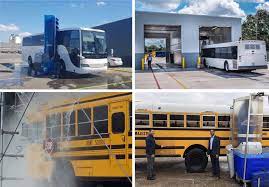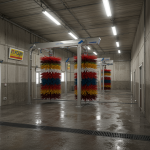In the hustle and bustle of our daily lives, we often overlook the intricate processes that help keep our cities running smoothly. One such process is the often overlooked but vital task of bus wash. Have you ever wondered how those large, gleaming buses stay so clean? In this article, we will unveil the secrets of bus wash, exploring how it works and why it matters.
Keeping buses clean isn’t just about aesthetics; it plays a crucial role in maintaining the functionality and longevity of the vehicles. Regular bus washes remove dirt, grime, and corrosive substances, preventing damage to the bus’s exterior and vital components. Moreover, a clean bus promotes a positive image for public transportation, enhancing passenger satisfaction and attracting new riders.
But how does the bus wash process work? From pre-rinse to high-pressure washing and spot-free drying, each step aims to effectively remove dirt and ensure a spotless finish. With environmentally-friendly techniques and advanced technology, modern bus wash systems offer efficiency and sustainability.
Join us as we dive into the world of bus wash, unraveling the mysteries and understanding why this seemingly mundane process holds great significance in keeping our cities moving forward.
Importance of bus wash
Keeping buses clean isn’t just about aesthetics; it plays a crucial role in maintaining the functionality and longevity of the vehicles. Regular bus washes remove dirt, grime, and corrosive substances, preventing damage to the bus’s exterior and vital components. Moreover, a clean bus promotes a positive image for public transportation, enhancing passenger satisfaction and attracting new riders.
Bus washes are not only about removing surface dirt but also about ensuring a safe and comfortable environment for passengers. Clean buses are less likely to harbor germs and allergens, contributing to healthier and more enjoyable journeys. Additionally, well-maintained buses with a clean appearance instill a sense of trust and reliability in the public, which is essential for a successful public transportation system.
Types of bus wash systems
There are various types of bus wash systems available today, each with its own advantages and features. Touchless systems use high-pressure water jets and detergents to remove dirt without physical contact with the bus. Friction systems, on the other hand, employ brushes and soft materials to scrub the bus’s surface.
Automatic bus wash systems are becoming increasingly popular due to their efficiency and convenience. These systems utilize advanced technology and sensors to automatically adjust the wash process based on the size and shape of the bus. Manual bus wash systems, although less common now, involve handwashing and require more time and effort.
How does a bus wash system work?
The bus wash process involves several steps, each aimed at effectively removing dirt and ensuring a spotless finish. It typically begins with a pre-rinse, where water is sprayed onto the bus to loosen and remove loose dirt and debris. This step is crucial in preparing the surface for a thorough wash.
After the pre-rinse, the bus enters the main washing area, where high-pressure water jets or brushes are used to clean the exterior. These systems are designed to reach all areas of the bus, including the roof and undercarriage, ensuring a comprehensive wash. Detergents and cleaning solutions are often used to aid in the removal of stubborn dirt and stains.
Once the bus is thoroughly cleaned, a spot-free rinse is performed to remove any remaining residue and ensure a streak-free finish. This step is crucial in achieving a polished and professional appearance. Finally, the bus enters the drying phase, where powerful blowers or air dryers remove excess water, leaving the bus dry and ready for its next journey.
Benefits of regular bus wash
Regular bus washes offer numerous benefits for both the vehicles and the public transportation system as a whole. Firstly, they help extend the lifespan of buses by preventing corrosion and damage caused by dirt, grime, and harmful substances. By regularly removing these elements, the bus’s exterior and vital components are protected, resulting in fewer maintenance issues and costly repairs.
Furthermore, regular bus washes contribute to the overall cleanliness and hygiene of the public transportation system. Clean buses create a pleasant and comfortable environment for passengers, enhancing their experience and satisfaction. This, in turn, encourages more people to use public transportation, reducing congestion and pollution on the roads.
Moreover, a clean bus fleet improves the public’s perception of the transportation system. It conveys a sense of professionalism, reliability, and attention to detail. Passengers are more likely to trust and have confidence in a transportation system that prioritizes cleanliness and maintenance.
Environmental impact of bus wash
In today’s environmentally-conscious world, it is essential to consider the ecological impact of any process, including bus wash. Fortunately, modern bus wash systems have made significant advancements in terms of sustainability and environmental friendliness. Many systems now incorporate water recycling and filtration technologies, reducing water consumption and minimizing waste.
Additionally, bus wash operators are increasingly adopting biodegradable and eco-friendly detergents and cleaning solutions. These products are formulated to effectively remove dirt and grime while being less harmful to the environment. By using these environmentally-friendly practices, bus wash systems contribute to a greener and more sustainable future.
Best practices for bus wash maintenance
To ensure optimal performance and longevity of bus wash systems, regular maintenance is crucial. Operators should adhere to manufacturer’s guidelines and recommendations regarding cleaning intervals, filter replacements, and equipment inspections. Regular cleaning and maintenance not only prolong the lifespan of the bus wash system but also help maintain its efficiency and effectiveness.
It is also essential to train and educate bus wash operators on proper techniques and procedures. This includes understanding the different settings and options available on the bus wash system, as well as how to troubleshoot common issues. By investing in proper training and maintenance, bus wash operators can ensure a consistent and high-quality wash for every vehicle.
Choosing the right bus wash system for your needs
When selecting a bus wash system, it is important to consider factors such as the size of the fleet, the type of buses being washed, and the available space. Touchless systems are ideal for delicate surfaces and vehicles with intricate designs, while friction systems offer a more thorough clean for heavily soiled buses. Automatic systems are recommended for large fleets with high wash volumes, as they offer efficiency and convenience.
Additionally, it is crucial to choose a bus wash system that aligns with your sustainability goals. Look for systems that incorporate water recycling and filtration technologies, as well as eco-friendly cleaning solutions. Consider the long-term costs and benefits of each system, including maintenance requirements and energy consumption.
Bus wash services and providers
For those who prefer to outsource their bus wash needs, there are numerous bus wash services and providers available. These specialized companies offer professional bus cleaning services, utilizing their expertise and state-of-the-art equipment to ensure a thorough and efficient wash. Outsourcing bus wash can be a cost-effective solution, particularly for smaller fleets or organizations without dedicated on-site facilities.
When choosing a bus wash service or provider, it is important to consider their experience, reputation, and range of services offered. Look for providers that have a track record of delivering high-quality results and maintaining excellent customer satisfaction. Consider reading reviews and seeking recommendations from other bus operators to make an informed decision.
Conclusion
In conclusion, the process of bus wash may seem mundane, but it holds great significance in keeping our cities moving forward. Bus wash not only maintains the functionality and longevity of buses but also promotes a positive image for public transportation. It contributes to passenger satisfaction, attracts new riders, and reduces the environmental impact of the transportation system.
By understanding the secrets of bus wash, including the various types of systems available, the process involved, and the benefits it offers, we can appreciate the importance of this often overlooked task. Whether outsourcing to a professional service or investing in an on-site bus wash system, prioritizing regular cleaning and maintenance is essential for a reliable and efficient public transportation system.
So the next time you see a gleaming bus on the road, remember the secrets behind its cleanliness and the vital role of bus wash in keeping our cities running smoothly.




